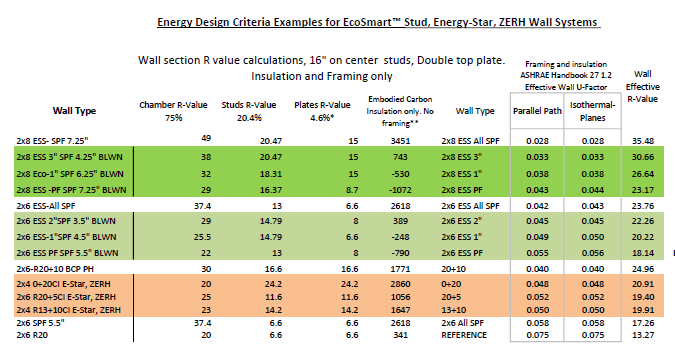Energy efficiency isn’t just a buzzword anymore, it’s a building standard. If you’re a builder, contractor, or designer looking to meet Energy Star insulation requirements or align your projects with ZERH requirements, understanding the U-Factor values and energy code requirements is essential. The good news is we have added a new document to the resources page for calculations needed for the Department of Energy (DOE) Energy Star and ZERH programs. Both programs reference the 2021 or 2024 Energy Code for the Insulation Envelope. Since the EcoSmart™ Stud (ESS) wall is not a Continuous Insulation (CI) wall assembly the 2021 and 2024 Energy Code requires an extra U-Factor calculation to be done. You need to be less than U 0.045 or above R-22 effective insulation for the exterior wall.
What Are Energy Codes?
Energy codes are standards set by federal and state bodies that regulate energy efficiency in buildings. These codes outline specific thermal performance levels that components like walls, roofs, and windows must meet. For residential construction, energy code requirements often specify U-Factor and R-Value thresholds to ensure homes are energy-efficient.
Both ZERH requirements and Energy Star insulation requirements are directly tied to these codes. Builders must meet or exceed these standards to qualify for certification under either program.
U-Factor Requirements for Energy Star and ZERH Programs
For exterior wall compliance, both Energy Star insulation requirements and ZERH requirements refer to a U-Factor threshold of less than 0.045 or achieving R-22 effective insulation. This is especially critical for builders using non-CI systems like the EcoSmart™ Stud (ESS).
Meeting U-Factor with the 2×8 ESS Wall System
With the 2×8 ESS, meeting energy code requirements is pretty straightforward. Regardless of the insulation material chosen, the combined system stays under the U-0.045 threshold. This makes it an ideal solution for builders pursuing compliance under both ZERH requirements and Energy Star insulation requirements.
U-Factor Calculations for the 2×6 ESS Wall System
For the 2×6 ESS with 1” of closed-cell 2 lb spray foam (SPF), the situation is a bit more nuanced. On its own, this setup comes very close to the U-0.045 threshold but may require additional calculation to ensure compliance.
However, once you account for other elements like OSB, sheetrock, and building paper, you typically add another R-2 to R-3 of effective insulation. This brings the overall U-Factor below 0.045, allowing the wall to meet both Energy Star insulation requirements and ZERH requirements.
Comparison with CI Wall Systems
It’s important to note that even approved CI wall systems do not meet the U-0.045 requirement unless all insulation components are factored in. The energy code requirements enforce strict rules for thermal performance, and it’s essential to perform a full system calculation rather than relying on individual material ratings.
Passivhaus Considerations: Go 2×8 ESS
Builders designing to Passivhaus standards or looking to exceed basic ZERH requirements should consider the 2×8 ESS. This wall system not only surpasses Energy Star insulation requirements, but it also meets or exceeds the exterior wall performance targets set by British Columbia’s Passivhaus program.
Embodied Carbon and Eco-Friendly Design
Since we are a DOE IMPEL 2023 cohort we tossed in the Embodied Carbon calculations for just the main insulation elements of the wall assemblies for good measure using the most common material used by contractors. For all foam products I used the HFO blowing agent information since the HFC is pretty much phased out, but always check your materials! Embodied Carbon is becoming a bigger issue when designing residential homes.
Next week, we’ll explore cost savings and return on investment for builders using the EcoSmart™ Stud in projects targeting Energy Star insulation requirements and ZERH requirements.
Until then, we encourage you to:
- Sign up for the DOE Energy Star and DOE ZERH programs
- Visit the EEBA website for building science resources
- Check out the Energy Star website for insulation guidelines
- Review the ZERH website for current standards
Till next week, Cheers!
